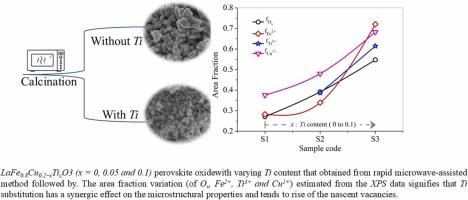Microstructural and electrochemical evaluations of Ti-substituted LaFe₀.₈Cu₀.₂₋ₓTiₓO nanostructures with nascent vacancies
IF 6.3
2区 材料科学
Q2 CHEMISTRY, PHYSICAL
引用次数: 0
Abstract
This study investigates the impact of Ti substitution on the microstructural and electrochemical properties of LaFe0.8Cu0.2–xTixO (x = 0, 0.05, and 0.1) perovskite oxide, which was synthesized via a rapid microwave-assisted method followed by calcination at 800°C for supercapacitor applications. XRD refinement revealed that Ti substitution induces nominal unit cell distortion and increases nascent vacancies. Raman and FTIR spectroscopy, which are sensitive to microstrain, supported the microstructural distortions indicated by XRD. Analysis of the Raman and FTIR spectra identified two prominent bands between 600–750 cm–1, associated with O/B site vacancies, with peak variations consistent with XRD's dislocation density findings. XPS data indicated that Ti substitution synergistically influences microstructural properties, enhancing vacancy formation. Electrochemically, electrodes and an all-solid-state asymmetric supercapacitor device incorporating LaFe0.8Cu0.2–xTixO exhibited promising energy storage capabilities. Increased Ti substitution in the electrode material achieved an impressive specific capacity of 488 C/g at a current density of 0.3 A/g and demonstrated excellent rate capability. The device displayed energy and power densities of 14.67 Wh/kg and 1199 W/kg, respectively, with a 98% retention of specific capacitance after 10,000 cycles, underscoring the material's durability in the device.

ti取代的LaFe₀₈Cu₀的微观结构和电化学评价。具有新生空位的O纳米结构
本研究研究了Ti取代对LaFe0.8Cu0.2-xTixO (x = 0,0.05和0.1)钙钛矿氧化物(x = 0,0.05和0.1)的微观结构和电化学性能的影响,该钙钛矿氧化物采用微波辅助快速合成,然后在800℃下煅烧用于超级电容器。XRD细化表明,Ti取代引起晶胞畸变,增加了新生空位。对微应变敏感的拉曼光谱和FTIR光谱支持了XRD表征的微观结构畸变。拉曼光谱和红外光谱分析发现,在600 ~ 750 cm-1之间有两个突出的带,与O/B位空位有关,其峰的变化与XRD的位错密度结果一致。XPS数据表明,Ti取代会协同影响其微观结构性质,促进空位形成。电化学方面,电极和含有LaFe0.8Cu0.2-xTixO的全固态非对称超级电容器器件表现出了良好的储能能力。在电流密度为0.3 a /g时,电极材料中Ti取代量的增加获得了令人印象深刻的488 C/g比容量,并表现出优异的速率性能。该器件显示的能量和功率密度分别为14.67 Wh/kg和1199 W/kg,在10,000次循环后保持98%的比电容,强调了该材料在器件中的耐用性。
本文章由计算机程序翻译,如有差异,请以英文原文为准。
求助全文
约1分钟内获得全文
求助全文
来源期刊

Journal of Alloys and Compounds
工程技术-材料科学:综合
CiteScore
11.10
自引率
14.50%
发文量
5146
审稿时长
67 days
期刊介绍:
The Journal of Alloys and Compounds is intended to serve as an international medium for the publication of work on solid materials comprising compounds as well as alloys. Its great strength lies in the diversity of discipline which it encompasses, drawing together results from materials science, solid-state chemistry and physics.
 求助内容:
求助内容: 应助结果提醒方式:
应助结果提醒方式:


